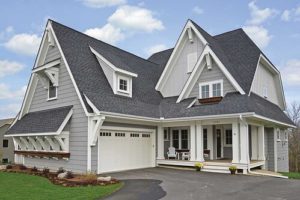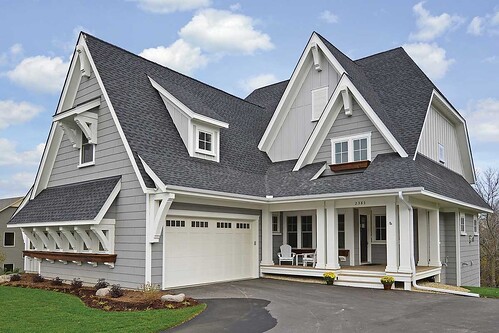When you purchase a new home, you’re inundated with numerous questions. How many bedrooms and bathrooms do you want? What type of flooring should be in each room? What about lighting options? And those are just the choices you need to make for the home’s interior. Don’t forget that decisions must be made about the exterior of the home, including what type of siding to have. Two of the more popular options include brick or vinyl siding, but how do you know which one is better?
Appearance

Image via Flickr by highmarke
The bricks used for a home’s exterior are made out of all-natural materials such as clay, lime, ash, or shale. They’re pressed into molds and fired at high heat in a kiln. If you’re wanting a rustic appearance for your home, you can’t go wrong with brick. Brick homes have been the standard of quality within the building industry for many years, and for good reason. This option also stands out and enhances your home’s curb appeal. However, the downside of brick is that the type of bricks available are limited.
Vinyl siding was introduced in the 1950s as an alternative to both wood and aluminum siding. It’s constructed out of durable plastic and molded to give it the look and texture of wood siding. As a thinner and lighter siding alternative, vinyl is available in a variety of colors to match your home perfectly. Certain companies offer a vinyl option that resembles brick, but it’s not authentic. It’s also perfect if you’re wanting a more contemporary style of home.
Longevity
When it comes to finding a siding solution that will last for years, it’s hard to compete with brick. You probably know that already if you’ve ever seen buildings or homes from the 1950s made out of brick. These homes last practically forever due to their durability. Brick is the sturdier option since it can last up to 100 years.
Vinyl doesn’t have the longevity like brick does since it has a life expectancy of about 20 to 25 years. However, if you’re someone who plans to move again somewhere down the road, you can always go with vinyl and have the next homeowner deal with replacing the siding.
Weather Resistance
Most brick manufacturers claim that brick is one of the most weather-resistant materials available because it doesn’t sustain damage from rain, the sun, snow, or ice. Brick is also considered a thermal mass, which means it stores and releases heat slowly. This allows the heat to stay out during the summer and stay in during the winter. However, while brick is extremely durable, the mortar that joins the bricks and creates a watertight exterior isn’t. Over time, mortar can develop cracks, especially as the home settles. If left unrepaired, these cracks can eventually let in moisture.
Not to be outdone, some siding manufacturers state that their siding is also weather-resistant and can withstand 180-mph winds. It does stand up to moisture well because it’s impermeable. However, due to the way it’s installed, vinyl is not water-tight. Water can seep in, especially if the siding is installed incorrectly.
Maintenance
When it comes to maintenance, brick requires very little involvement. You don’t need to paint the brick, nor does it dent or rust. It’s also considered fire and pest-resistant. Brick homes are more difficult to repair compared to vinyl ones, especially if you must remove sections of the bricks. Masons chisel away bricks, clean the area, lay mortar, insert new bricks, and add new mortar. You might also need to make mortar repairs, which typically occur every 20 years.
On the other hand, vinyl does require some maintenance. You’ll need to use a mix of detergent and water to remove any dirt or mold, and after about 10 to 15 years, you might need to replace or paint the siding due to fading. The material used in vinyl siding isn’t fire resistant; instead, it’s a slow-burning product.
Installation
Just like they have for hundreds of years, a professional mason uses mortar cement to hold the bricks in place. Even if you have multiple masons working on installing brick siding, you should factor in plenty of time for them to complete the task.
Unlike many other siding options, vinyl is easier to install and requires just a few specialty tools. You just need to make sure you hire someone who knows how to properly install vinyl siding so you aren’t caught with leaks and mold growth later on.
Price
Depending on your budget, this factor can be the most essential especially since they’re on opposite spectrums when it comes to price. Brick is one of the most expensive options available, coming in between $6 to $12 per square foot. According to HomeAdvisor, the average cost to add bricks to a 2,500-square-foot home is between $12,000 to $25,000. This amount includes the cost of materials and labor.
Vinyl is the more cost-effective option with prices coming in around $2 to $3 per square foot. HomeAdvisor states that the average cost to add vinyl siding to a 2,500-square-foot home costs between $6,000 to $16,000.
Bottom Line
Ultimately, you can’t go wrong with either vinyl or brick for your home’s siding. If you’re having difficulty deciding, you could always opt for brick on the front of your home and vinyl for the other sides. When it comes down to cost, vinyl siding is the more affordable option simply because vinyl was created to compete with wood siding. Brick siding is a more durable choice that will add value to your home and provide additional insulation. You might also want to reach out to your insurance company as you might qualify for a discount with brick siding.
Contact Steiner Homes Today!
Siding is one of the first aspects that people notice about your home, so it’s important to do your research before you choose either vinyl or brick siding. If you’re looking to build your home in northwest Indiana, contact Steiner Homes. We can walk you through every step of the home-building process from breaking ground to handing over the keys to your brand-new home. Let us help you navigate through these steps to build you the home of your dreams.

